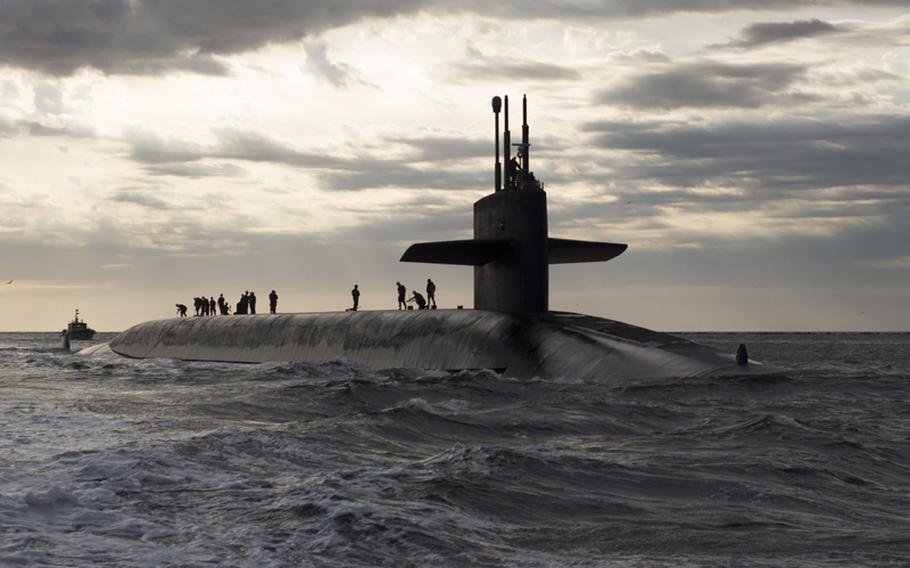Navy
Hagel: DOD to refocus on nuclear sub force after 'drift' in mission
Stars and Stripes July 10, 2014

The Ohio-class ballistic missile submarine USS Rhode Island returns to base March 20, 2013, after spending 3 months at sea. (James Kimber/U.S. Navy)
NAVAL SUBMARINE BASE KINGS BAY, Ga. — Secretary of Defense Chuck Hagel promised Wednesday that more money and attention will be paid to the Navy’s nuclear submarine force to correct for recent “drift” in the mission.
“I think over the years we’ve let our focus on the nuclear deterrence aspect of our national security drift a little,” Hagel told sailors, Marines and Coastguardsmen at a town hall meeting here.
“That’s somewhat understandable when we understand that for 13 years this country has been at war in long, large land-mass wars. And because of that, priority has been put on those wars, both in funding, leadership, attention. So we need to get back and pay attention here and prioritize the importance of the nuclear enterprise.”
Kings Bay, the Navy’s main ballistic missile submarine base on the East Coast, is home to six Ohio-class SSBNs, also known as boomers, each capable of launching up to 192 nuclear warheads.
Defense Department plans call for replacing all 14 aging boomers across the fleet with 12 modern vessels in the coming decades. Design work for the so-called Ohio Replacement is scheduled to begin in Fiscal Year 2017. Construction of the first Ohio Replacement boat is scheduled for 2021, with a first planned patrol to start in 2031, according to the U.S. Naval Institute website
“We have every commitment to the projections to bring on that new class of submarines. We need a new generation of Ohio-class submarines, and we’re going to prioritize that” in the budget, Hagel said.
The Ohio Replacement will be expensive, however, with the first boat costing an estimated $12.4 billion, according to DOD. And officials have cast doubt on whether the Navy would be able to fully execute its shipbuilding plan if sequestration budget cuts are not lifted by Congress in the coming years.
Hagel acknowledged the budget problems but insisted that Pentagon leaders “are continuing to be committed to a new generation of Ohio-class submarines.”
Hagel revealed that two separate reviews of the overall nuclear force — one internal and one conducted by outside experts — have been completed. He ordered the reviews earlier this year in the wake of cheating, drug and poor performance scandals involving Air Force personnel who were part of the nuclear enterprise.
The nuclear arm of the Navy had its own cheating scandal shortly afterward when answers to a written qualification propulsion exam were allegedly shared among some instructors at the Naval Nuclear Power Training Command near Charleston, South Carolina. The staff members accused of cheating were required to pass the test in order to qualify to instruct students on the training reactors.
The recently completed reviews focused mainly on management and personnel problems within the nuclear force.
“I’ve been briefed on the reviews. I’m in the process now working with our leaders to decide which recommendations we’re going to go forward with [to] strengthen the health of the nuclear workforce, strengthen the nuclear enterprise, [and] assure all of you that you’re going to have the resources you need to do your job,” Hagel told the troops.
The Pentagon chief later declined to discuss any of the findings or recommendations with reporters, saying decisions will be announced in the next few weeks.
Hagel also emphasized another important change within the nuclear enterprise: the integration of women into the Navy’s submarine force.
The Navy began integrating submarine crews in 2011, after the Navy officially changed the policy that had previously prohibited women from serving aboard submarines. More than 60 female officers now serve aboard 14 crews across the submarine community. Currently, women only serve aboard ballistic missile and guided missile submarines, but in October the Navy will start integrating female officers into the attack submarine force. Enlisted women will be allowed to serve on them beginning in 2016.
While touring the USS Tennessee at Kings Bay, Hagel held a roundtable discussion with 14 of them to talk about their experiences.
“The Navy has really broken through on so much of this,” Hagel said afterward.
Thus far, women officers have been restricted to serving aboard Ohio-class submarines, and there are no enlisted sailors on any of the underwater vessels. But plans call for female officers to start integrating into the Virginia-class attack submarine fleet in October, and enlisted women will be allowed to serve on submarines beginning in 2016, according to the Navy.
harper.jon@stripes.com Twitter: @JHarperStripes